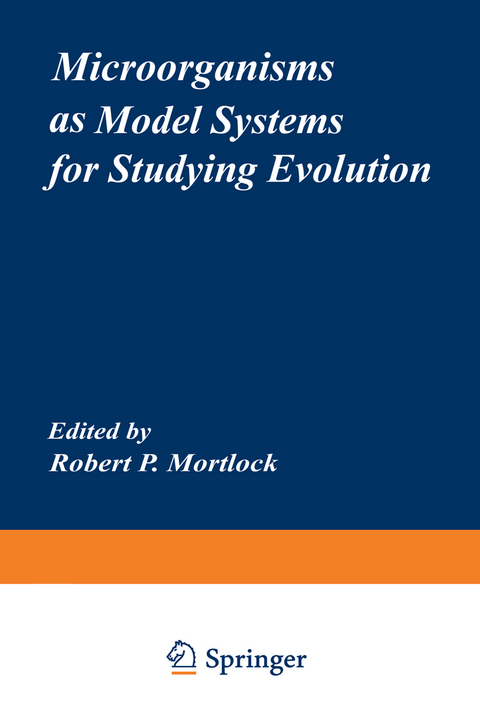
Microorganisms as Model Systems for Studying Evolution
Springer-Verlag New York Inc.
978-1-4684-4846-7 (ISBN)
1 The Utilization of Pentitols in Studies of the Evolution of Enzyme Pathways.- 1. Introduction.- 2. The Pentitols.- 3. The Utilization of Pentitols by Klebsiella Species.- 4. The Origin of the l-Arabitol Dehydrogenase Activity.- 5. Mutations Improving the Growth Rate on Xylitol.- 6. The Growth of Escherichia Coli Strains on Xylitol.- 7. The Utilization of Xylitol by a Mutant in the Genus Erwinia.- 8. Summary.- References.- 2 Experimental Evolution of Ribitol Dehydrogenase.- 1. Introduction.- 2. Pentitol Metabolism in Klebsiella aerogenes.- 3. Chemostat Culture of Klebsiella aerogenes on Xylitol.- 4. Evolution of Ribitol Dehydrogenase in the Chemostat.- 5. Fluctuating Selective Pressure.- 6. Transfer of the Klebsiella aerogenes Ribitol Dehydrogenase Gene into Escherichia coli K12.- 7. Evolutionary Lessons from the Chemostat Studies.- References.- 3 The Structure and Control of the Pentitol Operons.- 1. Introduction.- 2. The Structure of ?p rbt and ?p rbt dal.- 3. Bipolar Transcription of the Pentitol Operons.- 4. The Pentitol Operon Enzymes.- 5. Substrate Specificity of the Pentitol Operon Enzymes.- 6. rbt Messenger RNA.- 7. DNA Sequencing of the Pentitol Operons.- 8. Translation of the Two Kinases.- 9. Invert Repeat Sequences Enclose the Two Operons.- 10. Structure of an Experimentally Evolved Gene Duplication.- 11. Evolutionary Lessons from the Pentitol Operons.- References.- 4 The Development of Catabolic Pathways for the Uncommon Aldopentoses.- 1. The Structure of the Aldopentoses and Their Occurrence in Nature.- 2. The Pathways of Degradation of Aldopentoses by Coliform Bacteria.- 3. The Biochemical and Genetic Bases for the Establishment of New Enzymatic Pathways for the Degradation of Aldopentoses.- 4. Summary.- References.- 5 Functional Divergence of theL-Fucose System in Mutants of Escherichia coli.- 1. Introduction.- 2. Reversibility of NAD-Linked Reactions.- 3. A Mutant That Uses an NAD-Linked Dehydrogenase to Grow on l-1,2-Propanediol.- 4. Biochemistry of the Fucose System.- 5. Enzymic Changes in the Fucose System in Mutants and Revertants.- 6. Genetic Organization and Regulation of the Fucose System.- 7. Sequential Mutations Changing Propanediol and Fucose Utilization.- 8. Relationship of the Fucose and the Rhamnose Systems.- 9. Conversion of the Fucose System for d-Arabinose Utilization.- 10. Propanediol-Positive Mutants as Evolutionary Vanguards.- 11. Retrospective and Prospective Views.- References.- 6 The Evolved ?-Galactosidase System of Escherichia coli.- 1. Introduction.- 2. Development of the Evolved ?-Galactosidase System as a Tool for Studying Evolution.- 3. Evolution of Multiple Functions for Evolved ?-Galactosidase Enzyme: An Evolutionary Pathway.- 4. Kinetic Analysis of Evolved ?-Galactosidase Enzymes.- 5. Evolution by Intragenic Recombination.- 6. Allolactose Synthesis: Another New Function for Class IV Enzyme.- 7. The Role of Regulatory Mutations in the Evolution of Lactose Utilization.- 8. Directed Evolution of a Repressor.- 9. The Fully Evolved EBG Operon.- 10. A Model for Evolution in Diploid Organisms.- 11. Future Perspectives.- References.- 7 Amidases of Pseudomonas aeruginosa.- 1. Introduction.- 2. Amidase Regulatory Mutants.- 3. Amidase-Negative Mutants.- 4. Mutants with Altered Enzymes.- 5. Properties of Wild-Type and Mutant Amidases.- 6. Amidase Genes and Enzymes.- References.- 8 Structural Evolution of Yeast Alcohol Dehydrogenase in the Laboratory.- 1. Introduction.- 2. The Biochemistry and Regulation of Yeast Alcohol Dehydrogenase.- 3. The Mechanism of Allyl Alcohol Resistance.- 4.Amino Acid Substitutions in the Mutant ADHs.- 5. Altered Kinetics of the Mutants.- 6. Evolutionary Implications.- References.- 9 Gene Recruitment for a Subunit of Isopropylmalate Isomerase.- 1. The Leucine Operon in Salmonella typhimurium Wild-Type Strains.- 2. The Wild-Type Isopropylmalate Isomerase.- 3. Strains Carrying leuD Mutations Revert to Leucine Prototrophy.- 4. Model for Leucine Biosynthesis in leuD—supQ Mutant Strains.- 5. Leucine Biosynthesis in leuD—supQ Mutant Strains.- 6. Genetic Characterization of the leuD—newD Isopropylmalate Isomerase.- 7. Biochemical Characterization of the leuC—newD Isopropylmalate Isomerase.- 8. Theoretical Steps in the Evolution of a Complex Enzyme.- 9. Characterization of the newD (and supQ) Gene(s).- References.- 10 Arrangement and Rearrangement of Bacterial Genomes.- 1. Introduction.- 2. Chromosomal Rearrangements: Mechanisms of Change.- 3. Conservation of Global Gene Order: Mechanisms of Stability.- 4. Conclusion.- References.
| Reihe/Serie | Monographs in Evolutionary Biology |
|---|---|
| Zusatzinfo | XVIII, 326 p. |
| Verlagsort | New York, NY |
| Sprache | englisch |
| Maße | 152 x 229 mm |
| Themenwelt | Naturwissenschaften ► Biologie ► Evolution |
| ISBN-10 | 1-4684-4846-3 / 1468448463 |
| ISBN-13 | 978-1-4684-4846-7 / 9781468448467 |
| Zustand | Neuware |
| Haben Sie eine Frage zum Produkt? |
aus dem Bereich


